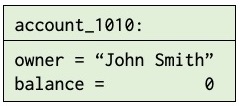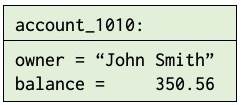A description written in a programming language is called a computer program or just a program, but is also referred to as source code or simply code.
The description of account_1010 in the previous section may be considered an example of a program, although it is not very useful since it is not used for any purpose.
Here we show an example of a program where money is deposited and withdrawn, represented as actions changing the balance of account_1010.
We may assign values to balance by an using assignment statements as shown here:
account_1010.balance := 350.56The expression account_1010.balance access the attribute balance of the object account_1010 and is an example of an attribute accessor.
Execution of this statement implies that balance in account_1010 now holds the value 350.56.
The operator := specifies that the variable account_1010.balance on the left-hand side gets a new value as specified by the expression 350.56 at the right-side of :=.
The action described by the assignment statement may represent a deposit of 350.56 on John Smiths account.
The assignment statement as shown above is just a program fragment and must be placed in an object in order to be executed. The next example shows such an object – our first example of a program carrying out actions:
myFirstProgram: obj
account_1010: obj
owner: val "John Smith"
balance: var float
account_1010.balance := 350.56As said, a program is an object descriptor like the one for myFirstProgram. The opposite is not the case since an object descriptor is not necessarily a program. We return to this in chapter .
This program is also an object descriptor that consist of the following items:
- The declaration of the object
account_1010. - The assignment statement
account_1010.balance := 350.56.
The object myFirstProgram may be executed by a computer and this implies the following actions in that order:
- The object
myFirstProgramis generated. - The object
account_1010is generated. - The assignment
account_1010.balance := 350.56is executed.
To illustrate what goes on during a program execution we use snapshots of (part of) the state of the program execution. The following figures illustrates what goes on at selected points of execution.
Below the right columns contain object diagrams that shows the stage of the account_1010 object at a given point of time during program execution. The left column shows the program text marked with a red arrow (–>) that shows the next statement to be executed at the time of the snapshot. If the arrow is pointing beyond the last statement, the next action to be executed is termination of the object.
The first snapshot shows the situation when account_1010 has been generated and before execution of the assignment:
- The
ownerattribute ofaccount_1010has the value"John Smith"since it is declared as constant using the keywordval. - The
balanceattribute has the value 0 (zero), which is the default value for data-items of typefloat.
myFirstProgram: obj
account_1010: obj
owner: val "John Smith"
balance: var float
--> account_1010.balance := 350.56
The next snapshot shows the situation after execution of the assignment statement:
myFirstProgram: obj
account_1010: obj
owner: val "John Smith"
balance: var float
account_1010.balance := 350.56
-->
- The data-item
balancenow holds the value 350.56. - The point of execution (–>) is at the end of
myFirstProgrampointing to an implicit action that when executed terminates execution of the object.
